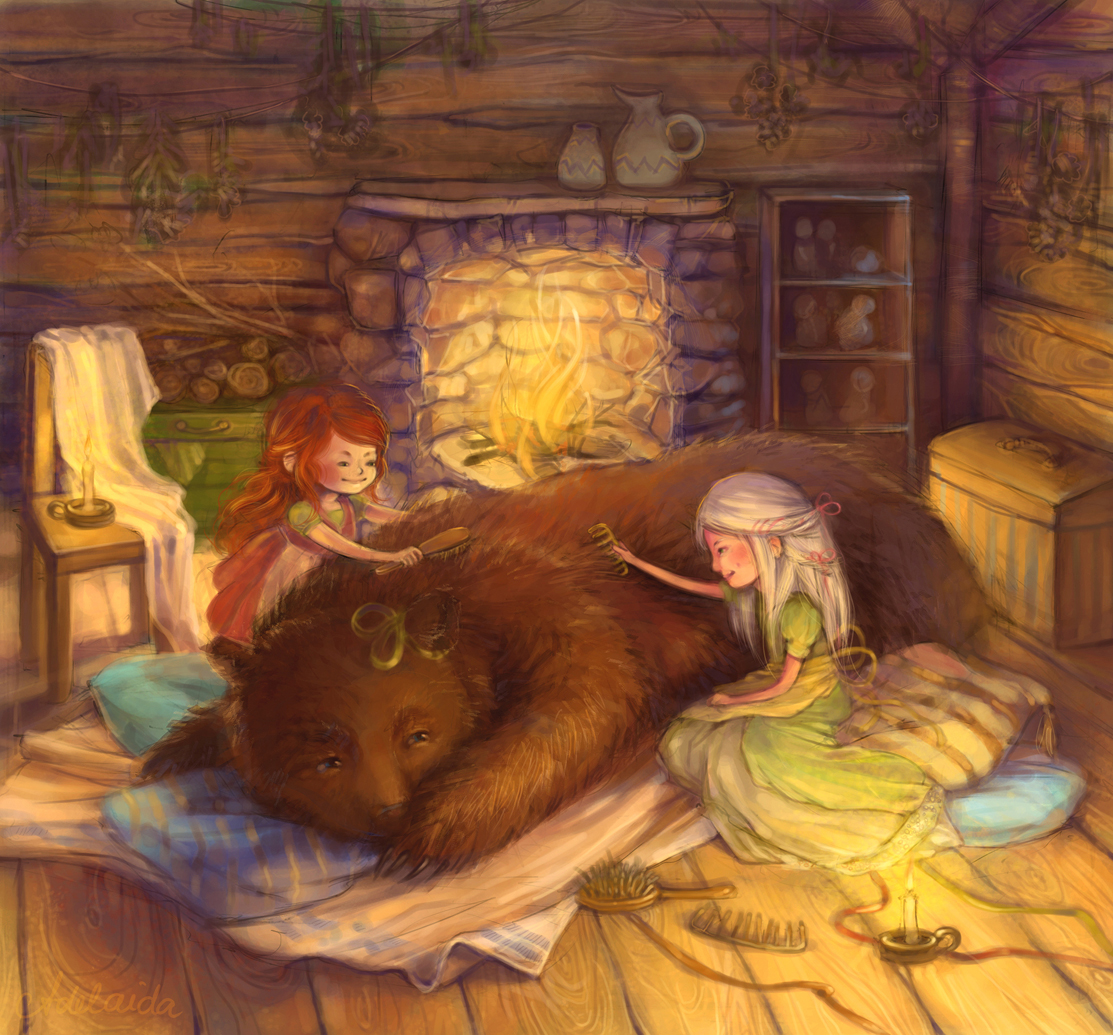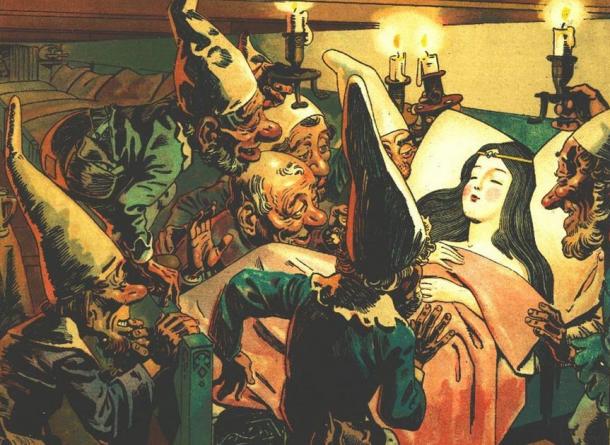Hey guys! Before we get to today's story, let me give you a quick rundown of my tentative schedule for the next several weeks
As I mentioned in my
previous post, January 28th is the Chinese New Year. As such, I'm planning on beginning a series of posts about Chinese mythology, starting on the 23rd. Both this week and next will be fairy tale fillers to tide us over until that series begins. (I'll admit, this is in part because I'm rewatching Once Upon a Time and am therefore in a fairy tale mood!)
With that said, let's begin!
I had thought that I had done a post about Snow White, but I was mistaken! I feel a little silly, having skipped over such an iconic fairy tale. Let's remedy that, shall we?
The story of Snow White is a little bit (okay, a lot) darker than the Disney version. The Queen is considerably more evil, and it's made all the more disturbing by the fact that Snow White is very young indeed in the stories. Did you know that Disney made Snow White fourteen? Having a fourteen year old fleeing attempted murder by her jealous, vain stepmother is really just a creepy story.
Once upon a time, there was a king and queen who were happily married. During one winter's day the queen was sitting by an open window, sewing. She pricked her finger on the needle, and three drops of crimson blood fell to the ground below. As she looked on them, the queen wished with all of her heart for a daughter with skin as white as snow, lips as red as blood, and hair as dark as ebony. The queen's wish eventually came true, for she had a daughter who looked exactly as she had wished - but the birth was difficult, and the queen died not long after.
Years passed, and eventually the king remarried. His new wife was most beautiful, but also exceptionally vain. She had a magic mirror, and she questioned it daily as to who was the most beautiful in the land. The mirror always responded that the queen was, and so she was pleased.
Yet as the years passed and Snow White grew up, she also grew more beautiful. One day the queen asked the mirror who the fairest in the land was, and he responded that it was Snow White, and not the queen. The queen was furious! She flew into a rage, and when she had finally calmed down, she did the logical thing...she plotted Snow White's murder.
(Okay, so maybe that isn't the logical course of action.)
The queen ordered the huntsman to take Snow White into the woods and kill her. He complied with the first part, but was so taken by Snow White's beauty that he found himself unable to murder the girl. Instead he warned her of her stepmother's plot to kill her. The huntsman told Snow White to run as far as she could. Hoping to deceive the queen, he killed an animal and brought her back its heart, lying and saying that the organ had belonged to Snow. The queen fell for his deception and was pleased.
Snow White found sanctuary in a tiny cottage in the woods. There were seven plates of food laid out on the table, and, being hungry, she ate from them. Tired, the girl then wandered into the bedroom, where seven tiny beds were laid out. She tried them out until she at last found one which was comfortable, and then she lay down to sleep.
When the owners of the house returned, they found everything moved from where it had been when the left. The seven dwarves began to speak, asking who had eaten their food, and who had been in their beds. Then the dwarf in whose bed Snow White was sleeping called them over to look - there was a girl in his bed!
The dwarves awoke Snow White, who told them her story. They were compassionate fellows, and quite moved by her story. They offered the girl sanctuary in their home, but warned her that whenever they were gone, she was not to open the door for
anyone.
The morning after Snow White's "murder", the queen asked the mirror her customary question. "Mirror, mirror, in my hand, who's the fairest in the land?" To her wrath, the mirror responded that it was Snow White who was the fairest of them all - meaning that the girl yet lived! Realizing that the huntsman had betrayed her, the queen decided to take matters into her own hands.
(This is where the story gets really interesting. Most versions of it leave out the first two murder attempts, sticking instead to the poisoned apple. But no, the apple was the queen's
third attempt at killing Snow White!)
First the queen disguised herself as a peddler of corsets and ribbons. The dwarves were away for work when she arrived at the cottage, and Snow White foolishly let herself be lured outside to look at the pretty lacy things the queen carried. Now, Snow had fled the castle in a bit of a hurry - what with the whole
running away from murder thing and all - and so she wasn't properly laced into a corset. The "old woman" pretended to be horrified at the lack of propriety, and offered Snow White a lovely ribbon for free, and even to lace her up! How kind of her.
But it was not kindness at all, for no sooner had Snow White agreed than the queen laced her so tightly that she could not breathe. The queen ran away laughing as Snow lay collapsed on the ground, believing the girl to be dead. Luckily, the dwarves arrived home soon after and cut the laces, revealing that Snow White had simply been in a dead faint.
(I couldn't help it, this scene always makes me think of Pirates of the Caribbean!)
The next morning, the queen was again enraged to hear the mirror respond that it was Snow White who was the fairest in the land. She again disguised herself and set out for the cottage. The dwarves had all left for work, but not before warning Snow White (again) to not open the door for anyone.
Snow White isn't the brightest apple on the tree.
Along came an old peddler, this time a woman selling hair combs. Again she was able to convince Snow White to exit the cottage, and again she offered the princess a gift - a small hair comb. Snow White was enamored of the comb, and agreed to the let the woman comb her hair with it. But - surprise, surprise! - the woman was actually the queen, and the comb was poisoned! No sooner had its tines touched Snow White's hair than the girl fell to the ground as though dead. The queen fled, cackling with her success.
Shortly thereafter the dwarves arrived home. Finding Snow White on the ground, they quickly removed the comb from her hair. As soon as it had been taken away, the girl awoke.
Rinse and repeat - the queen wakes up, the mirror tells her Snow White is still the fairest of them all. The dwarves leave for work, telling Snow to not, under any circumstances, open the door for anyone! (You'd think she'd listen by now, right?)
But this time...this time the queen didn't hold back. She turned to dark magic, and created the perfect weapon - an apple.
Now, this time Snow White was a little more wary when a strange woman selling things arrived at her door. She at first resisted. But the queen was cunning, and had created the apple so that one side was white, another red. The white side was harmless to eat, but the red was poisoned. She offered to split the apple with Snow White, to prove that it was safe. The girl relented when she saw the old woman bite into the white side of the apple. She left the cottage, took the red half, and took one bite -
- at which point she promptly fell to the ground, dead.
This time the queen's glee knew no bounds, for she knew she had won.
When the dwarves came home, I'll imagine they weren't too surprised to find Snow lying on the ground outside their cottage. They tried everything in their power to wake her up, but nothing worked. At last, they were forced to realize that the sweet young girl was dead. They buried her in a glass coffin.
Some time later, a prince happened to be passing through the forest. He came across the glass coffin, and the girl he saw inside was so beautiful that he instantly fell in love with her. He asked the dwarves if he could take the coffin with him and return it to his kingdom. It took some convincing, but at last the dwarves relented and agreed.
Modern adaptations have probably left people expecting a kiss at this point - but there was none. Instead, it was the jarring of the coffin being pulled to the horse which saved Snow White. The movement made the piece of apple which had been wedged in her throat fly loose, and she found that she could breathe again. The dwarves were delighted to find the girl alive - and the prince loved her just as much awake as he had asleep. He asked her to marry him, and she agreed.
The next day, the queen asked her mirror her usual question. She was horrified when it said that there was one fairer still than she - a new queen. Snow White's stepmother had been given an invitation to a royal wedding, but she had no idea who the bride was. Determined to see who it was who was more beautiful than she, the queen decided to attend the wedding.
When she arrived, she was stupefied to find that the bride was Snow White. The queen was frozen in place, too horrified to move. However, the prince was not - and he knew exactly what the queen had done to his beloved. A pair of iron boots had been warming next to the fire for just this purpose. They were brought over with a pair of tongs, and the searing-hot shoes were latched onto the evil queen's feet.
She was then forced to dance in them until she dropped dead...And that is how the story ends.
I hope you guys enjoyed Snow White! I've always been curious as to what happened to Snow's father. Did the queen murder him to gain power? Or was he alive, and just sitting back in his throne while his daughter fled from his murderous new wife? I'm not sure which is worse.
I'll see you next week!




















